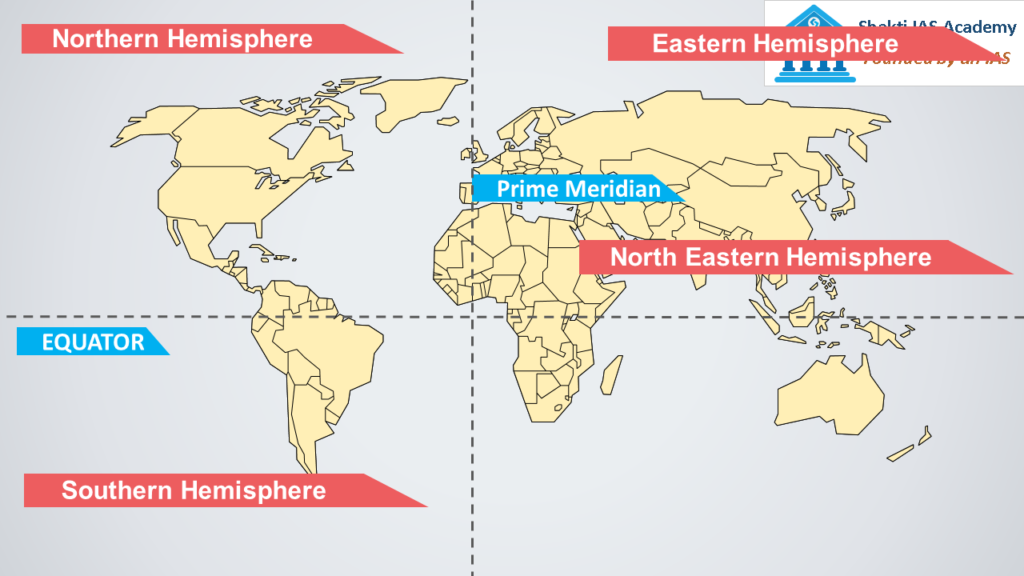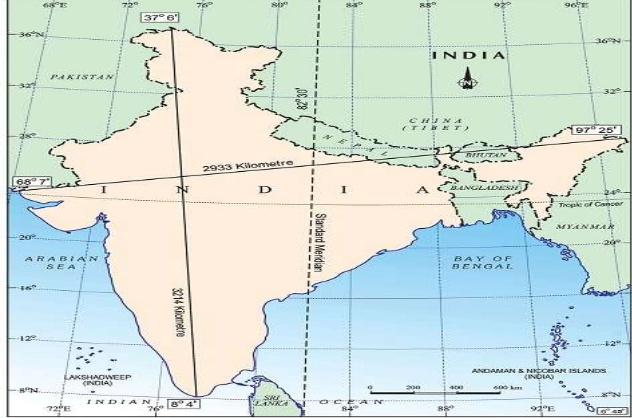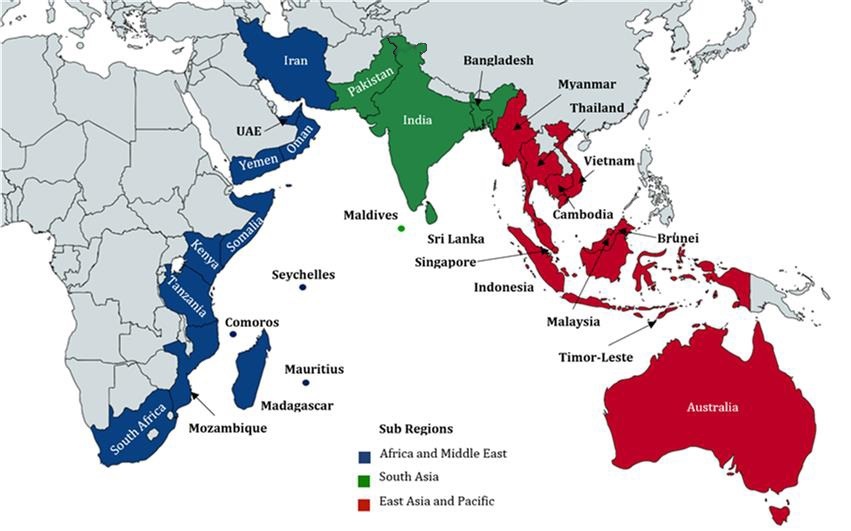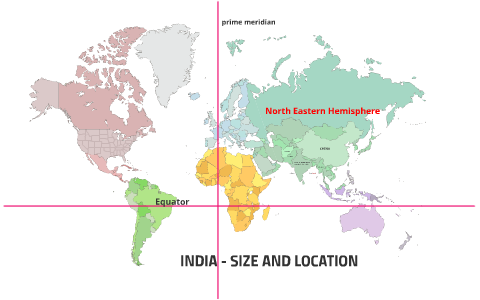India is located in both the Northern Hemisphere and the Eastern Hemisphere. This means that it is situated north of the equator, the imaginary line that divides the Earth into the Northern and Southern Hemispheres.
Additionally, India is to the east of the prime meridian, which runs from the North Pole to the South Pole and divides the Eastern and Western Hemispheres. Being in the Northern and Eastern Hemispheres influences India’s climate, seasons, and various geographical characteristics.
The Concept of Hemispheres (Northern, Southern, Eastern, Western

The Earth is divided into four main hemispheres – Northern, Southern, Eastern, and Western based on the cardinal directions. Each hemisphere represents a half of the Earth, and the division allows us to comprehend global geography. The Northern and Southern Hemispheres are separated by the equator, while the Eastern and Western Hemispheres are divided by the prime meridian.
What are the main hemispheres, and how do they divide the globe?
The Earth is divided into four main hemispheres based on cardinal directions. Here’s a simple table summarizing the main hemispheres and how they divide the globe
| Hemisphere | Location | Key Regions |
|---|---|---|
| Northern Hemisphere | North of the Equator | North America, Europe, Asia, parts of Africa |
| Southern Hemisphere | South of the Equator | South America, Australia, Antarctica, southern Africa |
| Eastern Hemisphere | East of the Prime Meridian | Europe, Asia, Africa, Australia, part of Antarctica |
| Western Hemisphere | West of the Prime Meridian | North America, South America, part of Antarctica |
What are the Geographical Coordinates of India?

Latitude and Longitude Coordinates Defining India’s Position
India is positioned between latitudes 6°44′ and 35°30′ north and longitudes 68°7′ and 97°25′ east. These coordinates provide a precise location on the Earth’s surface, allowing for accurate mapping and navigation.
Latitude measures north-south positioning, and India spans a wide range, contributing to its diverse climate and geography. Longitude, on the other hand, determines east-west positioning, emphasizing India’s vast territorial expanse.
Identifying the Hemisphere Based on Latitude and Longitude
The latitude coordinate places India predominantly in the Northern Hemisphere. This is evident from its location north of the equator, contributing to the country’s distinct seasonal variations. The majority of India, including major cities like Delhi and Mumbai, falls within the Northern Hemisphere, influencing factors such as climate and daylight hours.
India’s Unique Location in Relation to the Equator and Prime Meridian
India’s unique geographical position lies in its relationship with the equator and prime meridian. While the equator does not pass through India, the Tropic of Cancer, which is situated north of the equator, runs directly through the central part of the country.
This positioning contributes to India’s tropical climate and the occurrence of distinct seasons. The prime meridian, which passes through Greenwich, London, is crucial for determining India’s eastern longitude.
India spans multiple time zones, and its location relative to the prime meridian influences the country’s timekeeping and synchronization with global standards.
How does India’s hemisphere influence its diverse climate patterns?
India’s hemisphere significantly influences its diverse climate patterns through the interplay of the Earth’s axial tilt, its orbit around the sun, and the resultant variations in sunlight angles. Here’s a more detailed exploration
Tilt of Earth’s Axis
India, positioned in the Northern Hemisphere, experiences distinct seasons due to the tilt of the Earth’s axis. This axial tilt causes different parts of the Earth to receive varying amounts of sunlight at different times of the year.
Seasonal Changes
The axial tilt results in the changing position of the sun relative to the Northern Hemisphere. This movement leads to the four main seasons experienced in India – summer, monsoon, post-monsoon, and winter. Each season is characterized by specific weather conditions, temperature variations, and precipitation patterns.
Tropic of Cancer
The Tropic of Cancer, which runs through the central part of India, plays a crucial role. It marks the northernmost point where the sun appears directly overhead. During the summer solstice, the Northern Hemisphere tilts towards the sun, leading to more direct sunlight and warmer temperatures in India.
Monsoon Influence
The monsoon, a defining feature of India’s climate, is influenced by its hemisphere. The differential heating of the landmass and the Indian Ocean during summer creates a low-pressure area over northern India. This, in turn, draws moisture-laden winds from the southwest, resulting in the annual monsoon rains.
Temperature Extremes
The position in the Northern Hemisphere contributes to temperature extremes in India. Summers can be hot and intense, particularly in the central and northern regions, as they receive more direct sunlight. Winters are milder but can be chilly in the northern parts of the country.
Climatic Zones
India’s diverse climatic zones, ranging from tropical to alpine, are a direct consequence of its hemispheric location. Regions closer to the equator experience tropical climates, while those at higher latitudes have temperate and alpine climates.
Impact on Vegetation and Biodiversity
The diverse climate patterns influenced by the hemisphere shape India’s vegetation and biodiversity. Different regions support a variety of ecosystems, from dense tropical rainforests to arid deserts, contributing to the country’s ecological richness.
How does India’s hemispheric location impact trade routes and economic partnerships?

India’s hemispheric location significantly influences trade routes and economic partnerships. Being situated in the Northern Hemisphere, India has strategic access to both the East and West.
This geographic advantage positions India as a key player in international trade, facilitating connections between Europe, Asia, and the Middle East.
The Northern Hemisphere location contributes to efficient maritime routes, enhancing trade relations with countries across these regions.
Additionally, it plays a vital role in economic partnerships, as India becomes a crucial link in global supply chains. This geographic positioning not only shapes trade dynamics but also fosters economic collaborations, allowing India to leverage its location for strategic economic growth and international trade influence.
FAQ
In which hemisphere is Asia located?
Asia is located in both the Northern and Eastern Hemispheres. It spans a vast geographical area, extending from the eastern to the western hemisphere and from the northern to the southern hemisphere.
Is India located in the northwestern hemisphere?
No, India is not located in the northwestern hemisphere. India is situated in the Northern Hemisphere, and its geographical coordinates place it primarily in the Eastern Hemisphere.
Which hemisphere is Pakistan in?
Pakistan is located in both the Northern and Eastern Hemispheres. It shares a border with India and is situated to the northwest of India, within the same general hemisphere.
Which hemisphere is the USA?
The United States is located in the Northern Hemisphere. Geographically, it spans both the Western and Eastern Hemispheres, but its primary positioning is in the Northern Hemisphere.
What country is in all 4 hemispheres?
No single country is situated in all four hemispheres simultaneously. However, some countries, such as Russia, span across multiple hemispheres due to their vast geographical extents.
Which hemisphere is the UK in?
The United Kingdom (UK) is located in the Northern Hemisphere. While it is geographically positioned in the Western part of the hemisphere, its primary placement is in the Northern Hemisphere.
Final thoughts
Knowing that India is in the Northern Hemisphere helps us understand many things about the country. It affects the weather, the way people live, and how India connects with other countries. Whether it’s trade, culture, or the changing seasons, India’s place on the map plays a big role.
Learning about this helps us see how geography shapes the identity of a country and how it fits into the larger world. So, the next time someone asks, “Where is India?” you can share not just a location but a story of how geography weaves into the rich tapestry of India’s existence.



